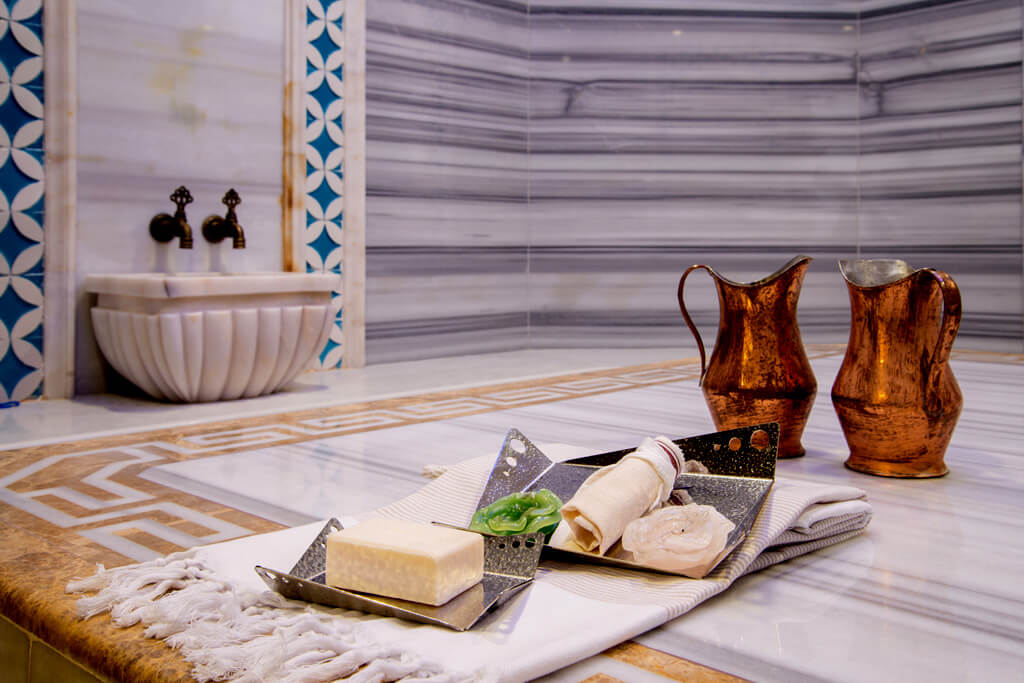A Turkish bath is something that everyone should try at least once in their lifetime.
The most impressive examples are found in Istanbul, capital of the Ottoman Empire and former capital of the Byzantine Empire. The Byzantines considered themselves the direct cultural successors to the Roman Empire, where public baths were a staple feature of the community and the Ottomans adopted and continued this practice when they conquered the Byzantines in 1450. The steam bath in Ottoman times had three basic functions: a place for social gathering; ritual cleansing and as an architectural witness to the sultan’s greatness, power and wealth. Particularly during the Ottoman Empire, hamams were a place for socializing. The bath was open from sunrise to sunset and frequented not only for washing but also for use of the barber, exchange of gossip and news, and even business meetings. In the ladies’ section, women could investigate the physical and social qualities of prospective daughters-in-law, enjoy music and entertainment, and indulge in sweets.
Visiting a Turkish Bath
Choices
The “traditional service” is recommended for a true Turkish Bath experience. Lasting around 45 minutes, an attendant will wash, scrub & massage you with suds and a handwoven wash cloth (kese). A cheaper alternative is “self-service” where you bathe yourself or you can go for a more” luxurious option” including an aromatherapy oil massage, facial mask, reflexology etc.
Procedure
Most traditional Turkish baths have separate sections for men & women, only the more touristic options will allow mixing so be sure to check beforehand if you wish to enjoy the experience as a mixed gender couple or group. Once you are shown to the locker area you then strip down and cover yourself with a peştemal (a thin cotton towel) before entering into the hararet or hot room. You can wear underwear but be sure to bring a dry set with you for later. Here you have time to relax and begin to sweat while lying on an impressive göbektaşı (raised marble platform in the center above the heating source). The hararet is most often the most beautiful section of a Turkish Bath, covered completely in marble. Once the masseuse/masseur (will always be the same gender as yourself) feels you are ready they will begin to douse you with warm water and lather you with a soapy swab. Once covered in suds you are then massaged and scrubbed. The scrubbing might feel a bit like being sandpapered but leaves your skin glowing and incredibly soft, well worth it! Also don’t be surprised by the amount of “dirt” (dead skin cells) that you will see has being scrubbed off. Showering every day just does not accomplish the same level of rejuvenation & cleanliness. Then follows a thorough rinsing after which you have the choice to either relax a while longer in the hot room or head on into the cooling down section. Here you are handed a new dry peştemal and given time to cool down, take a nap, even have a drink. Then head back to the lockers, dress and prepare to enter once more the outside world.
Best Turkish Baths in Istanbul
Cağaloğlu Hamam
Located close to Grand Bazaar, this is the last Turkish bath house that was built in the Ottoman Era. It was constructed in 1741 by two different Ottoman era architects. The beautifully detailed building with high domed ceilings, internal marble fountains, interior garden, and two levels of individual changing chambers are still a great delight. http://www.cagalogluhamami.com.tr/
Çemberlitaş Hamam
It is one of the oldest hamams in Istanbul, and the bath section was built in 1584 by the famous Ottoman architect, Sinan. The architecture of Çemberlitaş Hamam attracts not only travelers and locals, but many researchers, photographers, filmmakers and students also study this magnificent structure. A visit to Çemberlitaş hamam can be one of the best Turkish bathing experiences under the huge dome. http://www.cemberlitashamami.com/
Beylerbeyi Hamam
Located right next to Beylerbeyi Mosque and it is an Ottoman style wooden building built in 1778. Camekan, the section for changing clothes, has a wooden ceiling, ılıklık, the transition area from the cooling area to the hot bath room, has a nice marble fountain. The hot room has a small göbektaşı. There are total of thirteen kurnas, fountains, and four halvets, private rooms. Beylerbeyi hamam serves men and women on separate schedules. Ladies can visit in the morning till the early afternoon, and male customers can visit afterwards.
Hagia Sophia – Haseki Hürrem Sultan Hamam
This is another magnificent structure built by Sinan, the chief Ottoman architect. Hurrem Sultan, Roxelana, the wife of Suleiman the Magnificent, ordered it to be built in 1556. It was built where the ancient public baths of Zeuxippus (100-200 AD) used to stand, in the middle of Blue Mosque and Hagia Sophia. The last renovation that helped the structure regain its magnificent look started in 2008, took three years and cost 17million Turkish Lira. 1300 square meters of Marmara marble was used to restore the hamam back into its former glory. Although built as a classical Ottoman bath, this particular hamam was constructed in a way that the sections for men and women are on the same axis, as mirror images of each other. This is also one of the fanciest hamams in Istanbul, and they serve customers with 160 gold plated bath bowls along with silk and cotton (%50-50) mixture pestamals. http://www.ayasofyahamami.com/?rel=2
Süleymaniye Hamam
Built as part of the Süleymaniye Kulliye in 1557. A kulliye complex has numerous facilities around a mosque and the Süleymaniye complex includes Süleymaniye Mosque, a medrese, hospital, asylum, infirmary tombs, a hamam, a market and a primary school. Again, this is another work of the Ottoman architect Sinan, and it is one of the most touristy hamams in Istanbul. This part of the old city has been protected by the tourism authority and Süleymaniye Hamam has maintained its originality. Suleiman the Magnificent was the first to bathe here after a special ceremony and prayers. It has a similar plan to Haseki Hurrem Sultan Hamam. http://www.suleymaniyehamami.com.tr/





